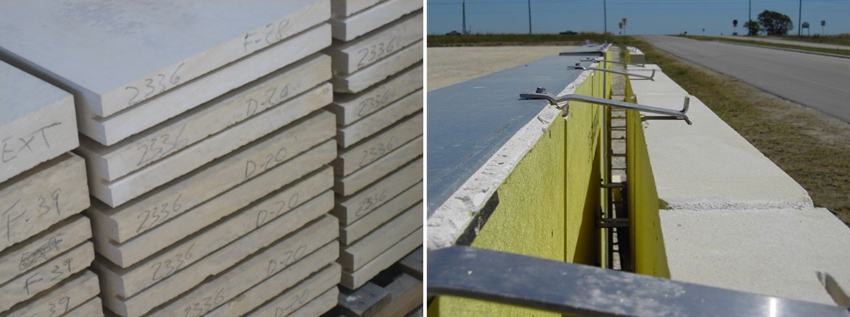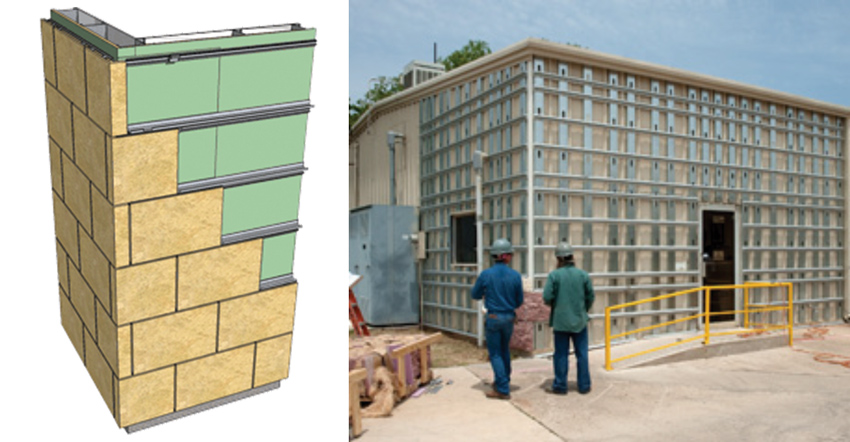Designing with Texas Limestone
INSTALLATION PROCESSES
The nature of cut stonework is such that most, if not all, of the cutting and finishing of the stone should be done at the stone-cutting plant, not in the field. There may be some minor exceptions, such as drilling holes for mechanical or electrical penetrations, that could not be anticipated ahead of time on shop drawings and fabrication. Aside from that, the architect, contractors, and stone supplier/fabricator should all anticipate a fully coordinated effort to provide the cut and finished stone in a condition where it is ready to be installed directly into the building. This is commonly facilitated by detailed shop drawings that identify and number each piece of cut stone that needs to fit on the building. The actual stone is then marked and identified with the same numbering system, making it possible to have the stone panels shipped to match the sequence of construction that is coordinated ahead of time.
The actual installation should follow the recommendations of the stone supplier for specific applications and of course be coordinated with other construction work. While stone is durable in place, it is important to realize that it can damaged, stained, or discolored during installation so it is very important that everyone is aware of proper handling for the safety of both the stone and those handling it. Those working in a stone-cutting plant will no doubt be quite well-versed in these techniques and can be a very valuable resource. They will be the ones making sure that the stone is packaged properly for safe shipment to the building where it will be installed. However, it is critically important that those receiving the stone understand that it must be moved, stored, and protected with care. Limestone should be unloaded following the instructions of the stone plant. It should be stored clear of the ground on non-staining skids, which also means that chemically treated wood should not be used. It should also be covered and protected from weather until it is installed on the building to avoid any possible discoloration.
Anchoring
Full-size stone panels need to be anchored to the building structure to be securely held in place, whether for interior or exterior installations. This is comparable to brick and masonry ties or anchors, which allow the outer surface to act as a non-structural veneer, holding only its own vertical weight, and using the anchors to transfer any lateral loads to the building structure. Such anchors for limestone are similarly designed and intended to secure the panels in place, keeping at least a 1-inch air/drainage gap between the stone and the rest of the wall, but not to incur any notable structural loads. Because of the chemical makeup of limestone, the anchors need to be made of stainless steel in order to hold up over time. Galvanized steel is generally not recommended except for relief angles.

Full-depth limestone needs to be anchored to the building structure by means of a groove cut in the middle of a stone panel that receives a stainless steel anchor, as shown in the example above.
Anchors for stone can come in a variety of shapes and sizes, but they are generally designed to fit into a horizontal groove in the center of the stone panels that is not visible when installation is complete. Generally, each panel will have multiple anchors with a leg that turns up or down into the prepared groove as the stone is set in place. Mortar will be set onto the stone or base below and will help secure limestone panels in place. The process continues until the entire wall is complete.
As mentioned earlier, the architect and the stone supplier need to work together to coordinate details between construction drawings and shop drawings, and this is particularly true for anchoring details. All of the specific anchoring details that need to be coordinated for a proper installation should appear on the stone cutting and setting drawings with review and approval of the architect. For example, projecting courses typically need to have beds in the wall at least 1 inch greater in depth than the projection, or else be specially anchored to the structure, and should be detailed on the stone cutting and setting drawings. These drawings should also detail all provisions for the proper anchoring, dowelling, and cramping of work in keeping with standard practices. If any stone needs to be supported by shelf angles, loose steel, etc., it should also be clearly indicated on the setting drawings. The overall result of proper detailing is a wall surface that meets the design requirements and is securely and permanently installed.
Metal Track System
An emerging alternative trend to the traditional stacking and anchoring type of installation is to use panels that will fit into a metal track system secured to the building structure. The metal tracks are comprised of vertical members that connect to the building structure and horizontal members that receive the cut stone panels. Unlike conventional stone-veneer systems, metal track systems attach to and hang on the wall structure, thus not requiring a concrete footing to support the weight of the masonry above. This feature alone can yield considerable cost savings. Further, since metal track systems like this can weigh as little as 14 pounds per square foot when using thin veneer stone, it can be easily designed into new or existing building projects using conventional construction techniques and existing wall studs. The track also removes the need for separate anchors and allows for the stone to be set in place based on coordinating the track geometry with the cut limestone geometry. This method allows for a much easier installation of the stone to begin with and the opportunity to make changes to the building facade in the future.

An alternative to traditional anchoring systems is to use a metal frame system that is designed to accept standard-size panels of cut stone, thus expediting installation and helping to control costs.
Installation systems based on using metal tracks are commonly based on standardized shapes to make things easier to coordinate. Standard nominal sizes for stone panels using these systems are 16 inches by 24 inches and 8 inches by 24 inches. Custom sizes may be available by special order so it is advisable to talk with a supplier to verify the size options. The use of these systems can also help achieve sustainable building design objectives. Aluminum channels and clips typically have at least 25 percent post-consumer recycled content, thus reducing the need for virgin material to be created. Further, the entire system can be dismantled and repurposed as the usage or occupancy of the building may change over its life cycle. Unused material can be fully recycled.
Sealing Limestone
Once the limestone is installed, it may be appropriate to seal it to protect the surface over time. Limestone has routinely been sealed for a number of reasons, the most common of which is to partially fill the pores in the stone and deter oil or water from penetrating through it. The most appropriate sealer to use is one that is siloxane based. That means it is comprised of silicon, oxygen, and alkane, which does not react unfavorably with the calcium carbonate makeup of the limestone. It also allows some transmission of air and vapor through the limestone so that any trapped moisture can escape rather than remain in the wall and cause damage.
The proper use of a sealer can yield other benefits, too. Specified and used correctly, it does not change color of newly cut stone, although it is always advisable to test a small area first to verify that. Existing limestone on a building may be affected by a sealer, but in this case it may actually help restore the stone to its original color and enhance its beauty. Either way, the sealer will allow the installed limestone to resist permanent staining from environmental or human sources. With less likelihood of stains and with a surface that can be easier to clean in general, that will help reduce long-term maintenance costs.









